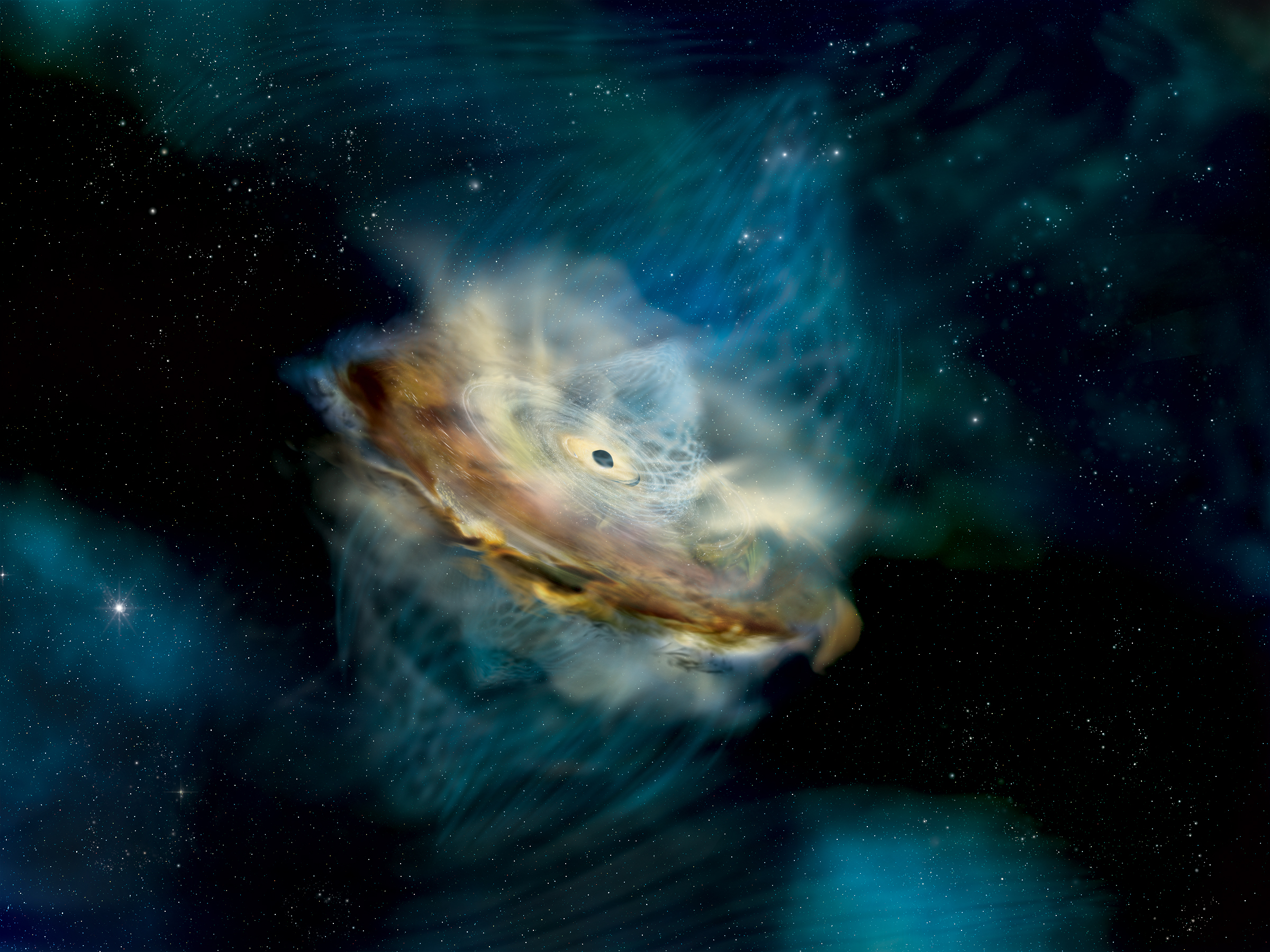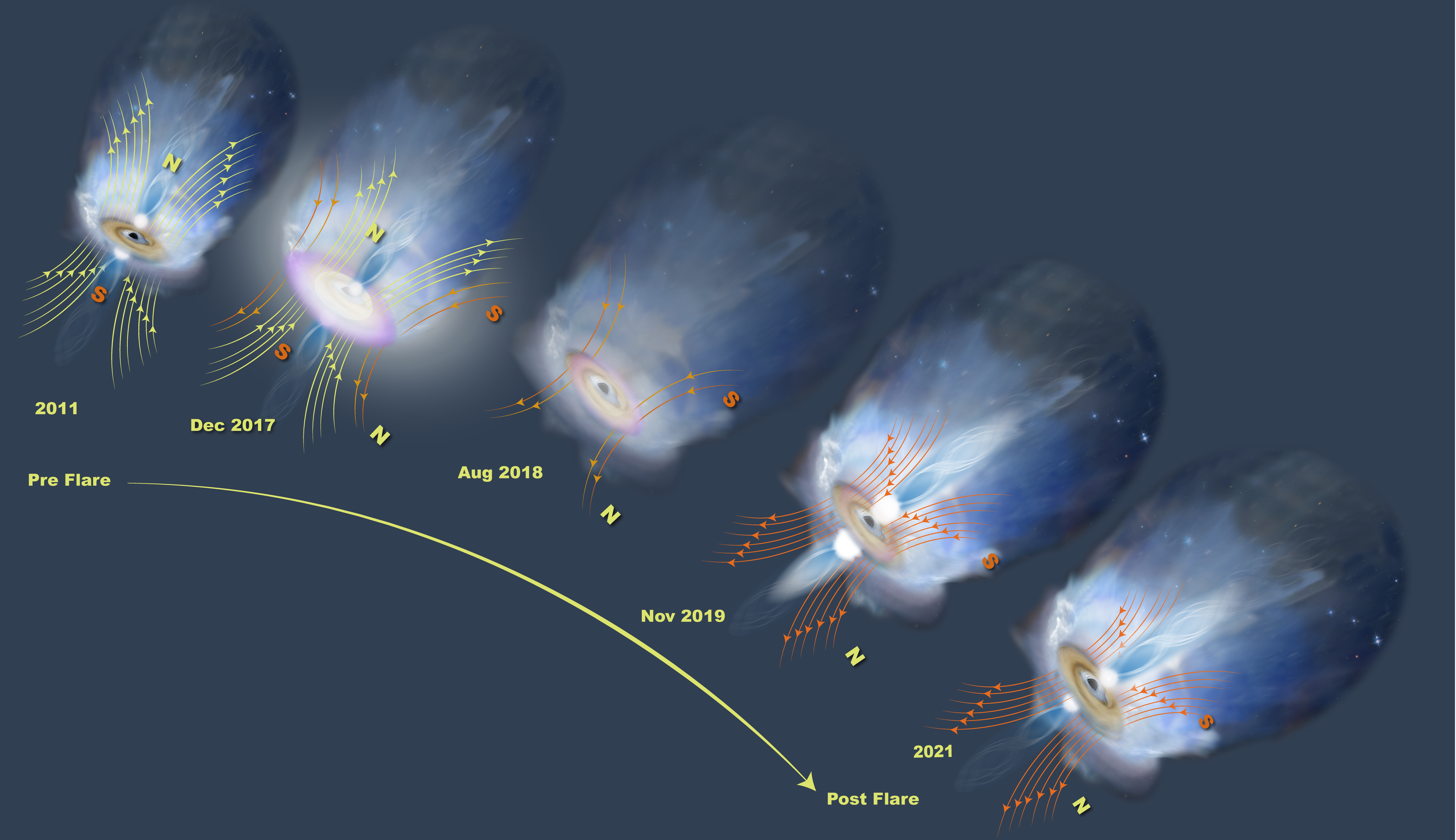Universe
ID: 14148
A rare and enigmatic outburst from a galaxy 236 million light-years away may have been sparked by a magnetic reversal, a spontaneous flip of the magnetic field surrounding its central black hole.
At the end of 2017, a galaxy called 1ES 1927+654 brightened by nearly 100 times in visible light. When NASA's Neil Gehrels Swift Observatory first examined the galaxy in May 2018, its UV emission was also 12 times higher but steadily declining, indicating an earlier unobserved peak. Then, in June, the galaxy’s higher-energy X-ray emission disappeared, later reappearing in October.
An international science team has linked these unusual observations to changes in the black hole’s environment that likely would be triggered by a magnetic switch.
Most big galaxies, including our own Milky Way, host a supermassive black hole weighing millions to billions of times the Sun's mass. When matter falls toward one, it first collects into a vast, flattened structure called an accretion disk. As the material slowly swirls inward, it heats up and emits visible, UV, and lower-energy X-ray light. Near the black hole, a cloud of extremely hot particles called the corona produces higher-energy X-rays. The brightness of these emissions depends on how much material streams toward the black hole.
The scientists think a magnetic reversal, where the north pole becomes south and vice versa, best fits the observations. The field initially weakens at the outskirts of the accretion disk, leading to greater heating and brightening in visible and UV light. As the weakening extends toward the black hole, the field can no longer support the corona and the high-energy X-rays vanish. As the magnetic field gradually strengthens in its new orientation, it restores the corona and the galaxy eventually settles into its pre-outburst state.



Magnetic Flip Drives Flare-Up of Monster Black Hole
At the end of 2017, a galaxy called 1ES 1927+654 brightened by nearly 100 times in visible light. When NASA's Neil Gehrels Swift Observatory first examined the galaxy in May 2018, its UV emission was also 12 times higher but steadily declining, indicating an earlier unobserved peak. Then, in June, the galaxy’s higher-energy X-ray emission disappeared, later reappearing in October.
An international science team has linked these unusual observations to changes in the black hole’s environment that likely would be triggered by a magnetic switch.
Most big galaxies, including our own Milky Way, host a supermassive black hole weighing millions to billions of times the Sun's mass. When matter falls toward one, it first collects into a vast, flattened structure called an accretion disk. As the material slowly swirls inward, it heats up and emits visible, UV, and lower-energy X-ray light. Near the black hole, a cloud of extremely hot particles called the corona produces higher-energy X-rays. The brightness of these emissions depends on how much material streams toward the black hole.
The scientists think a magnetic reversal, where the north pole becomes south and vice versa, best fits the observations. The field initially weakens at the outskirts of the accretion disk, leading to greater heating and brightening in visible and UV light. As the weakening extends toward the black hole, the field can no longer support the corona and the high-energy X-rays vanish. As the magnetic field gradually strengthens in its new orientation, it restores the corona and the galaxy eventually settles into its pre-outburst state.



For More Information
Credits
Scott Wiessinger (KBR Wyle Services, LLC): Producer
Francis Reddy (University of Maryland College Park): Lead Science Writer
Aurore Simonnet (Sonoma State University): Artist
Jay Friedlander (TRAX International): Illustrator
Scott Wiessinger (KBR Wyle Services, LLC): Animator
Barb Mattson (University of Maryland College Park): Narrator
Sibasish Laha (UMBC): Lead Scientist
Francis Reddy (University of Maryland College Park): Lead Science Writer
Aurore Simonnet (Sonoma State University): Artist
Jay Friedlander (TRAX International): Illustrator
Scott Wiessinger (KBR Wyle Services, LLC): Animator
Barb Mattson (University of Maryland College Park): Narrator
Sibasish Laha (UMBC): Lead Scientist
Please give credit for this item to:
NASA's Goddard Space Flight Center. However, individual items should be credited as indicated above.
NASA's Goddard Space Flight Center. However, individual items should be credited as indicated above.
Science Paper:
A radio, optical, UV and X-ray view of the enigmatic changing look Active Galactic Nucleus 1ES 1927+654
Short URL to share this page:
https://svs.gsfc.nasa.gov/14148
Mission:
Swift
This item is part of these series:
Narrated Movies
Astrophysics Animations
Astrophysics Features
Black Hole Week
Keywords:
SVS >> Galaxy
SVS >> HDTV
SVS >> Magnetic Fields
SVS >> Music
SVS >> X-ray
GCMD >> Earth Science >> Spectral/Engineering >> Ultraviolet Wavelengths
SVS >> Black Hole
SVS >> Astrophysics
SVS >> Edited Feature
SVS >> Space
SVS >> Swift
SVS >> Active Galactic Nucleus
NASA Science >> Universe
GCMD keywords can be found on the Internet with the following citation: Olsen, L.M., G. Major, K. Shein, J. Scialdone, S. Ritz, T. Stevens, M. Morahan, A. Aleman, R. Vogel, S. Leicester, H. Weir, M. Meaux, S. Grebas, C.Solomon, M. Holland, T. Northcutt, R. A. Restrepo, R. Bilodeau, 2013. NASA/Global Change Master Directory (GCMD) Earth Science Keywords. Version 8.0.0.0.0
A radio, optical, UV and X-ray view of the enigmatic changing look Active Galactic Nucleus 1ES 1927+654
Short URL to share this page:
https://svs.gsfc.nasa.gov/14148
Mission:
Swift
This item is part of these series:
Narrated Movies
Astrophysics Animations
Astrophysics Features
Black Hole Week
Keywords:
SVS >> Galaxy
SVS >> HDTV
SVS >> Magnetic Fields
SVS >> Music
SVS >> X-ray
GCMD >> Earth Science >> Spectral/Engineering >> Ultraviolet Wavelengths
SVS >> Black Hole
SVS >> Astrophysics
SVS >> Edited Feature
SVS >> Space
SVS >> Swift
SVS >> Active Galactic Nucleus
NASA Science >> Universe
GCMD keywords can be found on the Internet with the following citation: Olsen, L.M., G. Major, K. Shein, J. Scialdone, S. Ritz, T. Stevens, M. Morahan, A. Aleman, R. Vogel, S. Leicester, H. Weir, M. Meaux, S. Grebas, C.Solomon, M. Holland, T. Northcutt, R. A. Restrepo, R. Bilodeau, 2013. NASA/Global Change Master Directory (GCMD) Earth Science Keywords. Version 8.0.0.0.0











